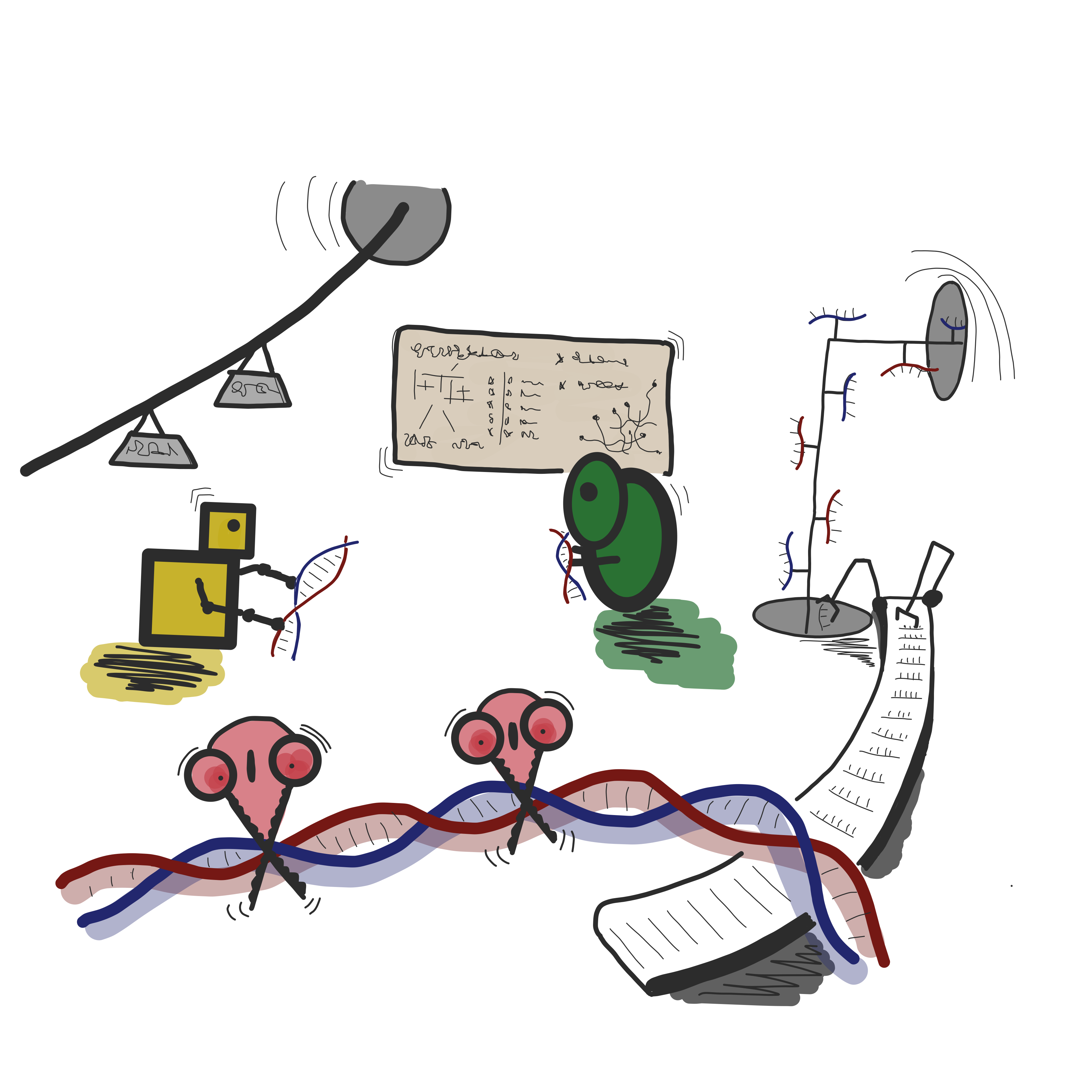Control, cut, CRISPR – how bacteria won this year’s Nobel prize

The cocktail of factors that causes disease is complex. Both external factors such as our environment or infectious organisms and internal factors like our genetic code, or DNA, can lead to ill-health. Whilst many conditions have been linked to multiple genetic factors simultaneously, there are other conditions in which a single fault, or mutation, in our DNA is the sole cause of disease. These include a blood condition known as haemophilia or Duchene’s Muscular Dystrophy (DMD, for short). Therefore, ongoing research aims to correct these mutations by exploiting biology’s control-copy-paste function, a field that is referred to as genetic editing; a field that won this year’s Nobel prize in Chemistry. Here’s the backstory.
Gene editing, or genome engineering, is an experimental technique in which the order of bases, the code in our DNA, are changed. Our DNA can be edited similarly to words in an instruction manual; some words and letters can be ‘deleted’, ‘substituted’ or ‘inserted’ using molecular tools that are akin to scissors and glue. Traditional therapies are designed to treat symptoms of a disease, but what if we could easily identify, edit and ‘reverse’ the molecular cause of multiple, debilitating diseases? The notion that scientists could correct the mutation and cure a disease using an engineering-like approach sounds like we’ve found gold at the end of the rainbow. However, several ethical and practical obstacles are still at play.
Since the birth of gene editing in the 1970s, scientists have developed several kinds of tools, known as TALENs and ZF-nucleases1 which comprised of a DNA binding domain, a section linked to a pair of molecular scissors and a nuclease protein which creates double-stranded breaks in our genetic code respectively. However, these approaches are fairly slow and require scientists to design highly specific, distinct molecular scissors for each gene they want to edit. What’s more, these approaches tended to have a high risk of off-target side effects due to a highly efficient but error-prone DNA repair mechanism, known as non-homologous end joining (NHEJ) – and therefore, were not suitable for clinical use. It would take years to refine and develop efficient nucleases… that is until the advent of CRISPR-Cas systems based on an antiviral defence system of Escherichia coli (E.coli), a bacterial organism2.
The foundations of this revolutionary technology were founded in an international collaboration between Jennifer Doudna3 and Emmanuel Charpentier4. As single cells, bacteria do not possess a defence system against pathogens yet they’ve developed a highly efficient way to fight their intruders! Perhaps unsurprisingly, for the time, many scientists disregarded this research as too niche to become the foundations of a momentous, medical discovery. However, since other leading researchers began to critique the true value of this CRISPR-mediated mechanism back in 2012 5, few scientists today can dispute its receipt of the 2020 Nobel Prize in Chemistry. Here’s how it works.
CRISPR, an acronym for an unusually organised repeated sequence in bacterial DNA, was first identified in 1987 but its biological purpose remained unknown until 2002. Scientists discovered that these repetitive sequences, known as loci, were always accompanied by additional, conserved sequences (or genes) that encoded a protein, to later become known as Cas6.
For gene editing, scientists design ‘guide’ RNA constructs, or sgRNA, which contain CRISPR sequences and complementary RNA to the gene of interest. sgRNA then directs Cas9, the molecular scissors, to a predetermined site on our genome. When designing guide RNA, scientists must include a short sequence known as a protospacer adjacent motif (PAM) which is essential to enable the cutting function of Cas9. To edit our DNA, scientists must also deliver a corrected ‘template’ into our cells which will be integrated into our DNA by repair machinery, or HDR.
Ongoing research continues to investigate how best to minimise off-target effects of genetic editing, in the hope that this technology will become more widely accepted into clinical applications. Recently, scientists have investigated the use of adjuvants, or additional compounds, to minimise off-target effects that occur due to the error-prone repair pathway. However, such approaches only add further complexity to the challenge at hand7.
Nevertheless, recent work has shown that CRISPR-Cas9 has been used for indirect clinical applications, more specifically to treat two blood disorders 8 and engineer a patient’s own immune cells for cancer therapy9. respectively. Early studies in primary human cells and mice have given hope that CRISPR- Cas9 technology may allow for direct correction of genetic fault, using advanced animal models of DMD.
Principally, selectively changing the genome is not a new phenomenon as agricultural specialists have already exploited gene editing to selective breed animals for desirable traits. Within the medical field, CRISPR-Cas9 has become a state-of-the-art research tool for exploring gene function by introducing random mutations and discovering genes involved in complex biological states including cancer and drug resistance. One of the benefits of CRISPR-Cas9 is that scientists can target multiple genes at once by introducing multiple guide RNA sequences and enough Cas9 protein to simultaneously edit several points in the genome.
From an ethical standpoint, it is easy to imagine the negative implications of genetic editing in humans, such as ‘designer babies’10. It is important to consider the legality of gene editing; in humans, genetic editing is restricted for the sole purpose of relieving suffering from serious health conditions and disease – so let’s not overlay scientific research with science fiction films. Although, it is reasonable to consider where boundaries lie between editing our ‘body’ cells or an individual’s ‘reproductive’ cells11.
Nevertheless, it remains fascinating that we can mimic a system found in bacteria to relieve human suffering from genetic diseases. If we consider our genome as a book, in which the letter ‘A’ is always swapped for the ‘Z’, CRISPR-Cas9 is the tool that will allow us to read the story. Undoubtedly, the discovery of the CRISPR-Cas9 system has been a reminder to us all that “solutions to problems come from unexpected directions”12. Will you help the scientists keep an eye out for the next one?
The author recommends reading Jennifer Doudna’s book, A Crack in Creation (Amazon) and watching their 2020 Nobel Prize interview (Youtube).
This article was specialist edited by Holly Kerr and copy-edited by Dzachary Zainudden.
References
- https://bioprocessintl.com/2016/therapeutic-gene-editing-tools-to-facilitate-basic-science-or-stimuli-for-a-paradigm-shift-in-biomanufacturing/
- https://www.youtube.com/watch?v=47pkFey3CZ0
- http://mcb.berkeley.edu/faculty/BMB/doudnaj.html
- https://www.mpg.de/9343753/wissenschahttps://creativecommons.org/licenses/by-nc-sa/2.0/ft-der-pathogene-charpentier
- https://science.sciencemag.org/content/sci/337/6096/816.full.pdf
- https://onlinelibrary.wiley.com/doi/full/10.1046/j.1365-2958.2002.02839.x
- https://pubmed.ncbi.nlm.nih.gov/27866654/
- https://www.newscientist.com/article/2246020-three-people-with-inherited-diseases-successfully-treated-with-crispr
- https://www.sciencenews.org/article/crispr-edited-immune-cells-cancer-clinical-trial
- https://news.harvard.edu/gazette/story/2019/01/perspectives-on-gene-editing/
- https://www.who.int/ethics/topics/human-genome-editing/WHO-Commissioned-Ethics-paper-March19.pdf
- https://www.youtube.com/watch?v=6SL2eEUvycI










